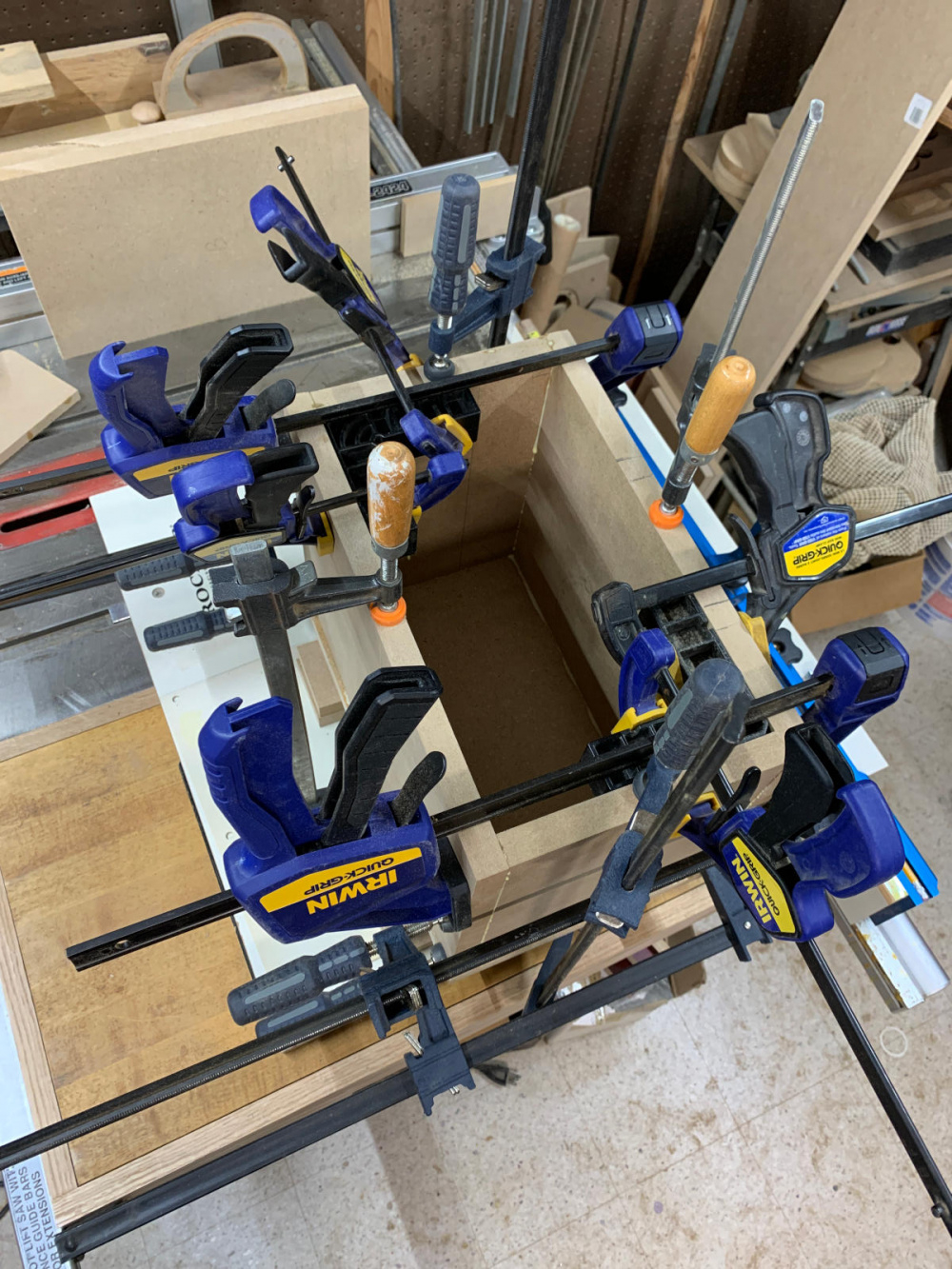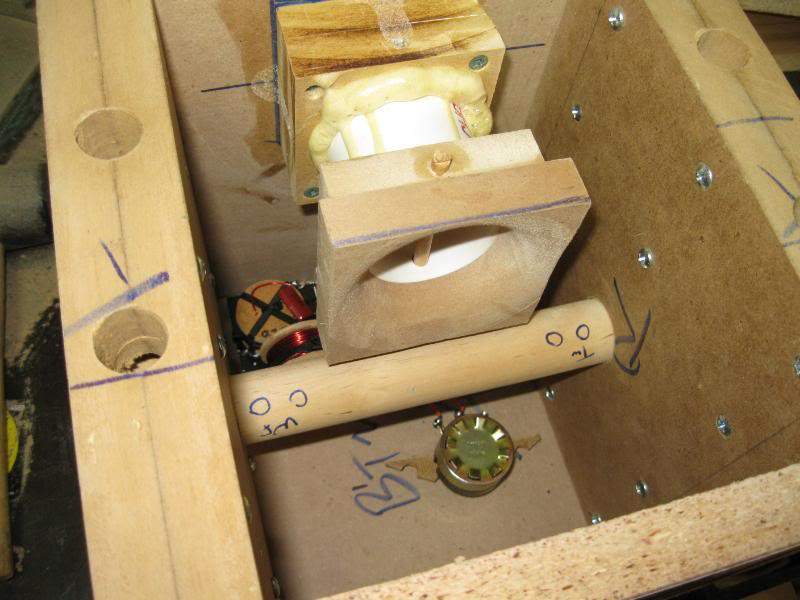Site Links
Howdy, Stranger!
It looks like you're new here. If you want to get involved, click one of these buttons!
Quick Links
Categories
Who's Online (3)
- DrewsBrews 6:41AM
- jholtz 6:41AM
- Tieftoener 6:41AM
Please review the site Rules, Terms of Service, and Privacy Policy at your convenience. Rules, TOS, Privacy
Get familiar with the reaction system: Introducing the Reaction System
Back in the shop!
Watching Craig work on three projects at once made me feel guilty that I have so many drivers on the shelf waiting to be deployed. A client postponed his shoot so I took the day off, cleared all the junk off the table saw, and started making sawdust. I'll be pairing an SB15NAC30-8 with a yet to be determined tweeter - possibly the Airborne RT-5002's I won in the raffle at Iowa DIY in 2018. I'm a little nervous about damaging those, but they're not doing any good just sitting on the shelf.
Well I'll be dipped - I actually have more than enough clamps. I only used 14 on this first box!









Comments
The 5002s are pretty robust. Any particular reason you afraid of damaging them?
That should be a nice pair of speakers!
Should AMT be treated similar as a Ribbon, measured with a cap? But AMT don't have a transformer. How to measure them? And are Planars the same or requires different handling?
Planars and AMTs are in the same category, much different from a true ribbon and much more robust. For frequency response measurements at 80-85dB I'd have very little worry of damage without using a cap.
With Omnimic bass removed tracks, If I recall the software included transfer function FRD files so you can apply an inverse transfer function to restore any errors in the response as a result of using the limited sweep. The downside would simply be elevated noise floor at low frequency. However, simply using bass removed tracks will not be good enough for a true ribbon as mentioned above.
I guess I was thinking they were somewhat fragile like a ribbon tweeter or mic.
Good to know! I don't have an Omnimic. I use ARTA, so I'll have to find if/where you can activate a HP filter. I know Holm has that function, but I can't generate frd files from that since I don't have Excel on my home PCs anymore.
Thanks guys. I'm not quite as nervous now. I built a quick jig for the 5002 last night, so it's full steam ahead. These should be similar to Craig's Keramiska - just a little taller and narrower. We'll see if I can do the crossover/voicing justice.
SW HP filters sometimes introduce other artefacts. In Holm, if I start the freq at 100 vs say 400, the response is unreliable.
Using cap would be the best option, even for dsp, do incase you got the highs and lows wires crossed, the tweets and amp is still protected and cap just becomes part of the circuit active or passive.
If there is any other fool proof way of doing it, I would like to know
I think those midbasses should reach the RT5002 okay. Recommendation; try measuring/voicing for an upward-tilting axis, about 15-20 degrees. This way the vertical off-axis is not such an issue. Don't be afraid to bring the 5002 level down to flatten it out as you have sensitivity to burn there.
InDIYana Event Website
Everyone needs to earn the blown up tweeter badge (imo), to date all of mine have been manufacturing defects
Manufacturing defects...yeah, that's exactly what I'm trying to avoid! I haven't blown up any hifi drivers yet - prosound compression drivers, yes.
I've had bad woofers, mids, and tweeters over the years. Only one or 2 have been toasted by accident.
InDIYana Event Website
I was reading your writeup on the Nephilas. It sounds like I should build a little box behind the RT-5002 to seal things up - correct?
No, the 5002 is a unidirectional tweeter. Heavy aluminum housing on the back side.
Must have been a different design/tweeter that I was looking at. Good - that's one less task to get these to the point of making sound. Tonight I tackle the bracing and port/terminal placement.
It was questionable to some if the 5002 was open via the input wires or not, and some felt it was emitting sound to the rear during operation. In actuality, I do not believe this to be the case. As a method of madness, I have always sealed up my planars with a backer to make sure there is nothing to leak in and create HD via woofer pressures.
InDIYana Event Website
I was back in the shop on Wednesday night for a few hours. I decided to make a new template for 2" Schedule 40, since that seems show up in so many projects. The Forstner bit left it a little tight, so let's try and open it up on the rarely used spindle sander. Drat, the first attempt took too much material. Let's try again! One light, quick pass around this time and now it fits just right. I haven't used the old Porter-Cable router in a long time. No slow start or speed control on that one. I forgot that it jumps a little when you power it up!
I had a bunch of angled scraps in the bin, so maybe I can use them for bracing. Cut them down on the tablesaw, added a little relief cut for the glue bead so I don't have to chisel it out - hey, this might just work out.
I'll cut a little wedge piece to tap down between the angled side pieces to tie them together - maybe even run some dowels up to the top too. We'll see...
Wow - this method works great. I don't think I'll even need clamps.
Yep- wedges are great.
Wanna clamp a port? Run a 1/4" hole through the inner port board edge-ways, and then likewise through the port so they line-up. Insert a 1/4" dowel all the way through after glue is applied. Use a flush-trim bit to remove from the inside after the glue is cured.

InDIYana Event Website
That's a great idea.
What type of glue did you use - looks like it foams.
Gorilla Glue Polyurethane Glue.
InDIYana Event Website
More progress - I cut corner blocks to attach the baffles out of some scrap oak in the bin. Added some corner bracing to the top. Got the port mounting plate glued & screwed in. The template I found for my terminal cutouts was too short in this orientation. The clamps got in the way of the router base. So I clamped on a temp extension piece and routed away! Glued and screwed the backing plate in and now that's ready when the binding posts I bought from Joey arrive.
Yay recessed posts!
It was easy since already had the template from something else. I think wanting them recessed comes from working in video & sound production for so many years. I see something sticking out the back of a cabinet and my brain says somebody is going to shear that right off.
Ready to attach the baffles, but I don't have long enough cap head bolts. I'll have to run to the hardware store in the morning.
Wolf - I'm getting close to measurements & I meant to ask you about this. Is it because of the fall-off in the vertical plane with longer ribbons/planars like this?
I had a different experience with my first 5002 design (so far, I have another pair) - I played with the crossover for a few weeks, and got everything flat and well behaved, ordered the final crossover parts and put the pair together. Listened to them next to my current reference design, and darn if they didn't sound a bit dark! I managed to squeeze in a parallel resistor on the crossover in the box, and brought the tweeter level up about 1 dB. Sounded real good then.
So now my design process is a lot of measurements and tweaking, serious listening, and then compare them side by side with a known good reference design. Sheesh. The trouble we go through so our stuff doesn't sound bad!
With the longer ribbon-style tweeter, and the shorter tower cabinet, angling up the lobe was beneficial for vertical response. No more than 15* is really necessary.
Don- are you above the tweeter at all? That can be the 'darkness' character cause. Angling the lobe fixes the lobing issue.
InDIYana Event Website
I understand that AMT and ribbons have limited vertical response, and I'm pretty sure that I was listening on tweeter axis.
But, sorry, I've never understood how to aim a lobe up or down!
Measure at desired axis or use PCD to offset the listening position.
InDIYana Event Website
Thanks
I've been wondering how the directivity issues change power response with these "tall" tweeters. Maybe that's what you were experiencing? I'm assuming we all have to find right the ratio of direct vs reflected energy in our own spaces.
That's my feeling also - power response in room, because it measured flat on axis quasi-anechoic.